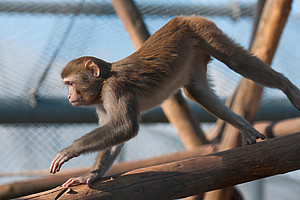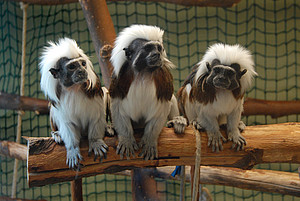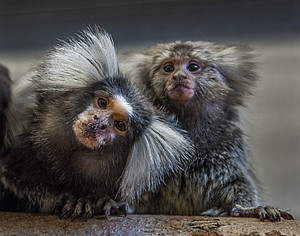Impact of herpes simplex viruses on the health of humans and non-human primates
Simplexviruses usually do not cause disease in natural hosts. Human infection with herpes simplex viruses (HSV), in particular of type 1, is frequent and the responsible viruses are exclusively circulating in the human population. Herpes simplex viruses have also been isolated from non-human primates (NHP), including herpes B virus of macaques, SA8 of African green monkeys, herpes virus papio 2 (HVP-2) of baboons and saimiriine herpes virus 1 of squirrel monkeys (SaHV-1). In their natural hosts, these viruses display similar biological properties as HSV in humans. The viruses first infect mucosal cells and then establish a latent infection in sensory ganglia. Sporadic reactivation results in the generation of progeny virions, which are found in various bodily fluids. Systemic infections and ensuing severe diseases in natural hosts are rare.
Simplexviruses can cause severe disease in accidental hosts. Herpes B virus can display extreme neuropathogenicity upon transmission to species other than the natural reservoir (macaques). Transmission to humans can induce encephalomyelitis which can take a fatal course in 70 - 80 % of patients in the absence of treatment. Moreover, the saimiriine herpesvirus 1 (SaHV-1) can cause severe disease upon transmission to marmosets (callithrix spp), tamarines (saguinus spp) and owl monkeys (aotus trivirgatus). Finally, infection of new world NHP and prosimians with HSV of humans and with herpes B virus can result in severe disease.
Herpes B virus infection of humans can be fatal. It is believed that herpes B virus transmission to humans invariably causes disease. Thus, antibodies against herpes B virus were never detected in persons who had frequent contact with NHP without signs of herpes B virus induced disease. Roughly 50 cases of herpes B virus infection of humans are known of which 21 took a fatal course. The risk for fatal disease can be reduced by early application of antiviral therapy, for instance valaciclovir and acyclovir. However, important questions regarding herpes B virus infection remain unanswered. It is unknown why all documented cases of human infection with herpes B virus occurred in the US, frequently within primate centers. Moreover, it is unknown why herpes B virus infection was never observed in persons with frequent contact to macaques in the wild.
Antibodies against herpes B virus serve as marker for infection. For detection of herpes B virus infection PCR (detects viral genomes) and ELISA/ Western blot (detect antibodies) are used. Reisolation of the virus is also possible, but requires access to BSL3 (Germany) and BSL4 (USA) laboratories, respectively, and is not successful in all cases. The results of antibody-based diagnostic tests need to be interpreted with care: The generation of antibodies in infected animals can be delayed and antibody levels can fall below the limit of detection. Moreover, detection of herpes B virus-specific antibody responses in humans is complicated by the cross-reactivity of antibodies raised against HSV. Diagnosis of human infection is offered by Georgia State University, Atlanta, USA, (http://www2.gsu.edu/~wwwvir/).
References
Eberle R, Jones-Engel L. Understanding Primate Herpesviruses. J Emerg Dis Virol. 2017 Mar;3(1).
Rohrman M. Macacine Herpes Virus (B Virus). Workplace Health Saf. 2016 64(1):9-12.
HERPES B VIRUS. EAZWV Transmissible Disease Fact Sheet No. 28. c.ymcdn.com/sites/www.eazwv.org/resource/resmgr/Files/Transmissible_Diseases_Handbook/Fact_Sheets/028_Hepatitis_B_Virus.pdf
HERPESVIRUS HOMINIS (Types 1 and 2). EAZWV Transmissible Disease Fact Sheet No. 31. c.ymcdn.com/sites/www.eazwv.org/resource/resmgr/Files/Transmissible_Diseases_Handbook/Fact_Sheets/031_Herpesvirus_hominis.pdf
HERPESVIRUS TAMARINUS (Herpes T-Virus, Herpesvirus platyrrhinae, Herpesvirus saimiri type 1, Alphaherpesvirus saimiri). EAZWV Transmissible Disease Fact Sheet No. 32. c.ymcdn.com/sites/www.eazwv.org/resource/resmgr/Files/Transmissible_Diseases_Handbook/Fact_Sheets/032_Herpesvirus_Tamarinus.pdf



